Content
- 1 Characteristics of radish for open ground
- 2 The best early ripening varieties
- 3 Best mid-season radish
- 4 The best late varieties
- 5 How to grow a good harvest of radishes
- 6 Popular varieties
- 7 Shooting resistant
- 8 For planting in open ground
- 9 Late ripening
- 10 Early ripening
- 11 Features of Radish Heat
- 12 Early ripening radish - harvest in 16 days
- 13 Early Varieties - Heat or Early Red?
- 14 Mid-season varieties - the golden mean
- 15 Late-ripening varieties - harvest by autumn
Radish is a nutritious and healthy root vegetable, without which it is impossible to imagine a summer salad. Radish is easy to grow in the open field, this vegetable does not require special care - only pre-sowing soil preparation, timely weeding and regular watering are important. In order to get a good and friendly harvest on the site, you need to choose the right seeds, taking into account the ripening time of root crops.
The best varieties of radish for open ground
Radish photography
Characteristics of radish for open ground
Radish is a cultivated plant that has been bred for centuries. Before the advent of scientific agronomy in Europe and Asia, peasants for centuries selected the strongest and largest root crops in order to get the best seeds from them. Today, hundreds of varieties of cultivated radish have been bred.
Radish
This plant belongs to the family of cabbage, cruciferous, radish - the closest relative of the selection and wild-growing radish. The modern cultivated radish was bred in different regions, all varieties are divided into Chinese and European groups (and a small Japanese group).
Important! Radish for open ground is one-year and two-year. Seeds are harvested from annual plants at the end of the growing season, from biennial plants the next season. Root crops in both species are edible in the first season. Interestingly, this vegetable has edible not only roots, but also leaves (tops), and the mustard oil contained in it creates a peculiar taste of the pulp.
Table of seedlings of the harvest of varieties of radish
Radishes are the very first vegetable that can be grown in the garden in early summer. It is a source of natural vitamins and minerals. The tender and crispy pulp contains a lot of vitamin C, all B vitamins, salicylic acid, PP and E vitamins. Root crops contain a lot of iron, magnesium, potassium, fluorine, phosphorus, sodium and other microelements. Both seeds and greenhouse seedlings are planted on open beds.
Radish photo
The best early ripening varieties
There are dozens of varieties of early maturing radish, breeders once every few years supply the market with new early maturing hybrids of this root crop. Selective early-maturing radish varieties have a number of advantages over mid- and late-maturing ones. They allow you to quickly, within a month after sowing, get a crop, are little susceptible to viral and fungal diseases.
- The time from planting seeds to harvesting is 16-25 days. Worms that infect root crops do not have time to spoil them.
- Early varieties of radish often have a round or flattened, less often - a long root crop.
- The diameter of round fruits is 2-6 cm. The length of oval roots is 4-6 cm with a diameter of up to 1.5 cm.
- The leaves of the plant are eaten only by the cruciferous flea, which is fought with the help of folk remedies and pesticides.
- The growing season from sowing to harvesting a marketable crop is 16-25 days, so early varieties can be planted up to 3-4 times during the summer season.
- Early ripening radishes are planted mainly by seeds in the ground, without growing seedlings.
- The best and most popular early ripening varieties - Zarya, Duro, Zhara, Rubin, Children's, French Breakfast, Zlata, Rondar F1, Pervenets F1, 18 days, Early Red.
Firstborn F1
This hybrid variety allows you to harvest as early as 16-19 days. The tops of the vegetable are low, and the root vegetable is bright red, raspberry red and rather large (30-35 g). Up to 3.9 kg of yield are obtained per square meter. The pulp is sweetish and does not have a strong mustard flavor.
Firstborn F1
The plant tolerates heat well, you can plant this vegetable several times, from April to August. Good resistance to root cracking is a positive feature. Firstborn F1 rarely shoots (resistant to flowering).
Radish seeds Pervenets F1
Heat
The popularity of this variety is ensured by its high yield (up to 2.8-3 kg per square meter). Fruit weight - 15-30 g. The April sowing of radishes must be protected from spring frosts using plastic wrap.
Radish of the Zhara variety grows well not only in the middle lane, but also in Siberia and the northern regions. The roots look very attractive, with a rounded shape and bright red, deep red and crimson red color.
Radish Heat
Important! Fruits are crispy, juicy, with firm granular white pulp. The sharpness of the fresh pulp does not cause a strong burning sensation in the mouth. Heat contains a lot of vitamin C.
The positive qualities of this variety include the amicable ripening of root crops, which is important for those gardeners who grow radishes not only for themselves, but also for sale. The period from planting to harvest is 16 to 25 days. The weight of root crops reaches 30 g.
Heat Radish Fruit
Radish Heat can be planted in the ground as soon as the snow melts in the garden. Or in August, as this plant does not tolerate the heat and the scorching sun.
Rondar F1
The harvest of radish Rondar F1 in the garden is obtained for 18-21 days, up to 3 kg of root crops can be grown per square meter. The skin color of the fruit is bright crimson, red, and the flesh is white and has a characteristic aroma. Rondar is a high-yielding radish (up to 3.5-3.6 kg per square meter). Rondar rarely throws out arrows, grows well with little shade of the site in the morning or afternoon.
Radishes keep well in the refrigerator and will hardly wither for 10 days or more. The leaves of this plant are short, so the seeds can be planted quite close to each other (at a distance of 5-7 cm). The weight of root crops reaches 15 g, they do not crack even at large sizes.
Radish Rondar F1
French breakfast
This radish is very popular in the Moscow region and the middle lane. The long, cylindrical fruits of this radish are dark pink or pink in color at the top, the root and bottom of the root are white.
Radish French Breakfast
The weight of the fruits reaches 45 g, the harvest can be harvested 25-27 days after sowing the seeds. The radish pulp is pleasant, without tart bitterness and excessive pungency. The French breakfast only gives arrows in extreme heat.
Best mid-season radish
Mid-season varieties grow more slowly. They can be planted in garden soil with seeds two or three times per season. April crops at night should be covered with plastic wrap.
- The growing season of mid-season varieties is from 30 to 36 days.
- The best gardeners consider Helios, Autumn Giant, White Nights, Albu, Saksu RS, Würzburg 59. All of them have a good taste, a characteristic smell and mustard tart taste. Bitterness and sweetish aftertaste are different for different types of mid-season radishes.
- The sprouts in the garden give amicable shoots, are resistant to early and autumn frosts and summer heat, they are all high-yielding.
- The shape of the fruit is round, flattened or elongated oval.
- The diameter of round fruits is 2-7 cm, long roots grow up to 10-15 cm.
- The size of the fruit is generally larger than that of the early radish.
- The leaves of young sprouts can be eaten by a cruciferous flea, overgrown roots are small worms.
Mid-season radish
Alba
Alba roots are white, oval, with white juicy pulp. They are lightweight (22-35 g), the growing season from seeds is 32-36 days.
Vegetable growers consider this radish to be one of the best varieties, since it is stored for a long time, while the pulp does not become flabby. The taste of Alba is very good, the flesh is almost not bitter. Up to 2-3.5 kg of products are collected from one square meter. The big advantage of culture is its resistance to arrow formation. This radish grows well in mid-latitudes.
Radish Alba
Autumn giant
This radish needs 30-35 days to grow. The autumn giant grows to 140-170 g, the color of the peel and pulp of the fruit is white. The vegetable has good taste, thanks to its thick peel, it can be stored in a cool place for several months, and in the cellar until spring.
On a note! The shape of the roots is elongated, conical, tapering at the tip. Their length reaches 8-9 cm with a thickness of 5-6 cm. The taste of the vegetable is tart, medium-sharp, reminiscent of the taste of a white radish. The autumn giant grows well in the southern and middle latitudes of Russia and the CIS countries.
Radish Autumn Giant
Würzburg 59
This vegetable is classified as a mid-season or mid-late crop. The growing season is 25 to 35 days. Radish has a rounded, red root vegetable with a diameter of 3.6 to 4.2 cm. The delicate white or pinkish flesh has an excellent taste and is almost not bitter.
The smooth peel of vegetables does not crack if the radish has time to outgrow. The weight of the fruits is small - from 14 to 18 g. The yield of this radish is high and depends on the farming region. Radish Würzburg 59 during long-term storage practically does not fade, retains freshness and beautiful appearance.
Radish Wurzburg 59
The best late varieties
Late varieties of radish are planted once a season. Most of the late species produce large fruits with thick skin. Among them there are varieties that are delicate in taste and with a pronounced radish taste.
- All late-ripening radishes are well kept.
- The harvest ripens only at the beginning of August, in the regions located north of Moscow at the end of August.
- The duration of growth of root crops ranges from 42 to 56 days or more.
- The best late varieties include Ice Icicle, Zenith, Dungan 12/8, Autumn Giant, Red Giant, Octave.
- Young shoots can be damaged by a cruciferous flea.
Cruciferous flea
Ice icicle
This radish has an unusual appearance. The root vegetable is similar to an icicle of a pointed conical shape and reaches a length of 15-18 cm. The flesh of the fruit is very juicy, crunchy, with a characteristic odor and pleasant taste. The bitterness in this radish is insignificant, and the taste is slightly spicy.
Radish Ice Icicle
Radish can be eaten within 25 days after planting with seeds, and root crops reach commercial size in 40 days. This variety can be stored in the cellar during the winter, and the Ice Icicle is planted in early August for planting for the winter.
The vegetable tolerates well not only night and day temperature drops, but also autumn frosts. Ice icicle does not belong to high-yielding crops, but more than 2 kg of products can be removed from a square meter. The popularity of this variety is ensured by its unusual appearance, juiciness and good taste.
Ice icicle
Red Giant
Red Giant is considered one of the best varieties of mid-season radish, it is grown both in personal plots and on farm fields. It is a late ripening vegetable that can be stored in a cellar or refrigerator for several months. During storage, the root crop does not become flabby and hollow.
Depending on the region, the time from sowing seeds in the ground to reaching the average fruit volume is 35-50 days. Up to 4 kg are harvested from a square meter. The root crop of the Red Giant is cylindrical, pink or red, with white, very juicy flesh. Its bitterness is insignificant, and its taste is highly appreciated. The red giant contains a lot of vitamin C, the weight of root crops ranges from 80 to 300 g.
Radish variety Red giant in the photo
Dungan 12/8
One of the best varieties of late round radish is Dungan 12/8. It is famous for its high yield - gardeners remove up to 3.5 kg from a square meter. Radish roots are large, round, their diameter reaches 7 cm, and their weight is 40-75 g.The fruits have a deep red color and white, juicy, crunchy flesh with a weak pungent taste.
The growing season, depending on the region of cultivation, takes from 48 to 55 days. Dungansky radish ripens in September and stays well in the cellar until spring. It can also be stored in the refrigerator for several months.
Dungan 12/8 is an unpretentious variety with increased resistance to drought and high air temperatures
How to grow a good harvest of radishes
Even excellent seeds do not guarantee a good harvest if the place for the beds is not chosen correctly and the soil is not prepared. All radish varieties love sunlight and flat areas. In the shade, the plants stretch strongly upward. They will grow long tops, while the roots will be small. The step-by-step preparation of the beds and sowing should be carried out in accordance with the rules of modern agronomy.
Step 1. If the soil is not nutritious enough, humus or compost and ash are sprinkled on it before digging up the beds.
Digging up the beds
Step 2. On highly depleted soils, dry potassium sulfate, superphosphate, urea are applied in the quantities indicated by the manufacturer.
Wood ash
Step 3. The beds are dug to a depth of at least 20-25 cm.
Step 4. The land is leveled with a rake and ridges are finally formed.
Formation of ridges
Step 5. The seeds can be soaked in water with a growth stimulant for 24 hours.
In the photo, radish seeds
Step 6. On the beds, grooves are made with a depth of no more than 1 cm.The distance between them should be at least 20 cm.
Step 7. Seeds are sown in the grooves.
Sowing seeds into grooves
Step 8. The grooves are sprinkled with crushed earth with a layer of 0.7-1 cm and watered carefully.
Watering crops
Step 9. When the shoots sprout, the radish will need to be thinned out, leaving 8-10 cm between shoots.
Care of crops of radish
Table. Composition and amount of fertilizers for planting radishes in open ground.
| Humus | 3 Kg | Spread over the site and dig up the ground |
| Compost | 3 Kg | Spread over the site and dig up the ground |
| Ash | 0.5 cups | Spread over the site and dig up the ground |
| Potassium sulphate | 1 tablespoon | Dissolve in 10 liters of water and pour onto the garden bed after digging. Can be sprinkled dry before digging in. |
| Urea | 1 teaspoon | Dissolve in 10 liters of water and pour onto the garden bed after digging. Can be sprinkled dry before digging in. |
| Superphosphate | 1 tablespoon | Dissolve in 10 liters of water and pour onto the garden bed after digging. Can be sprinkled dry before digging in. |
Important! A good future harvest requires weeding the ridges and watering. Gardeners should pay attention to the control of pests that eat young foliage.
Watering radish seedlings
The concept of "best grade" is somewhat arbitrary, since different varieties of radish are suitable for the southern, middle and northern regions of Russia and the CIS countries. In areas with cold, short summers, it is better to plant early-ripening radishes, and in areas with strong fluctuations in daily temperatures, cold-resistant varieties. Radish, which does not tolerate the summer heat, is not suitable for the south. Dozens of varieties of radish can be found on sale, so it will not be difficult to find seed for any region.
Video - The best varieties of radish
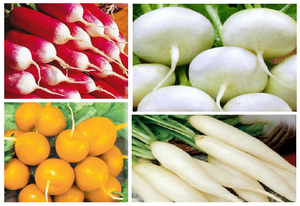 Radish grows as the first spring vitamin delicacy on most garden estates. The vegetable is resistant to cold snaps, ripens quickly, requires a minimum of maintenance. It has taken root with us so much that rarely does anyone think that the radish of the variety familiar to our eyes and taste is not the only one. In his "kingdom" there is a huge variety of "representatives", which differ in very different parameters.
Radish grows as the first spring vitamin delicacy on most garden estates. The vegetable is resistant to cold snaps, ripens quickly, requires a minimum of maintenance. It has taken root with us so much that rarely does anyone think that the radish of the variety familiar to our eyes and taste is not the only one. In his "kingdom" there is a huge variety of "representatives", which differ in very different parameters.
Basic classifications of radish
 Radishes are classified into different types based on certain characteristics.
Radishes are classified into different types based on certain characteristics.
Geographic origin:
- European radish. The species familiar to us are common in most countries of the European continent. The average growing season is a month, six-leaf rosette, weight up to 30 g.
- Chinese (Lobu). Bred in China and Mongolia.Big variety. Often differs from European in light color and cylindrical shape, although red and round are found. Growth period 50 days, rosette up to 10 sheets, usual weight 200 g.
- Japanese (Daikon). "Originally" from ancient times, but is considered a subspecies of Lobu. It is also called the Indian "mule".
The groups differ mainly in the structure of the root crops and the aboveground part. In Russia, European varieties of the first group are planted everywhere, although Chinese and Japanese are found little by little.
Depending on the growing season:
- Annuals - yield and seeds in one year.
- Two-year-olds - in the first season they give only root crops.
By ripening time:
- Early ripe. 16-18 to 25-30 days.
- Mid-season. They come to technical maturity in a month or a little later.
- Late. Ripen from 36 days to one and a half months.
By color:
- Green radish is native to northern China. It tastes sweet, not too spicy. The color of the pulp is yellow-green.
- The black color of the vegetable is typical for Spain. There it has a sharper and more aromatic taste.
- White radish is common in Japan, although it can also be found in other countries. Keeps better, tastes good.
Most radishes are red or yellow in color with shades.
At the place of landing:
- For open field, early varieties of radish are desirable, which will better withstand the vicissitudes of the weather. These include "18 days", "Duro", "Poker F1", "Presto", "Champion".
- The cultivars preferred for greenhouse production should grow calmly in low light. Here time-tested "Korund", "Premier", "Rhodes", "Rubin".
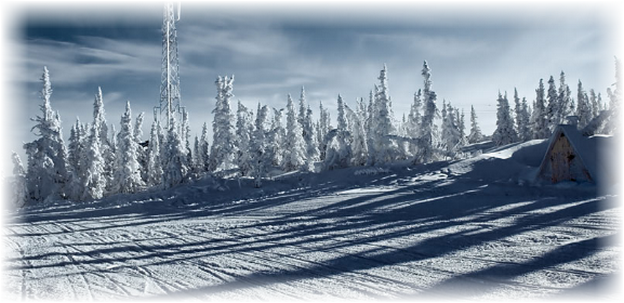 In the region of cultivation, it is worth paying attention to the varieties of radish that are best suited for Siberia. Since the climate conditions there are more difficult and nature does not have much time for maturation. Here the radish of the Zarya variety has proven itself well - early ripening, juicy, with decent yields. Sowing also: "Variant", "Deka", "Ilke" and others.
In the region of cultivation, it is worth paying attention to the varieties of radish that are best suited for Siberia. Since the climate conditions there are more difficult and nature does not have much time for maturation. Here the radish of the Zarya variety has proven itself well - early ripening, juicy, with decent yields. Sowing also: "Variant", "Deka", "Ilke" and others.
Lovers of large radishes can be interested in the varieties "Red Giant", "Slavia", "Poker F1". Most gardeners will love the non-shooting examples: "18 days", "Corsair", "Mokhovskoy", "Rhodes", "French breakfast". Among the new varieties of radish, practitioners especially note "Alex", "Duro" and "Zlata", which quickly give the fruits of excellent taste and are well stored.
The best and most popular varieties of radish
 A high-quality selection of radish seeds can be made not only by widely advertised Dutch varieties, but also by any others, including domestic ones.
A high-quality selection of radish seeds can be made not only by widely advertised Dutch varieties, but also by any others, including domestic ones.
Most varieties are equally suitable for greenhouse soil and open beds, sown in open soil in late April or early May. During the longest summer days, it is shaded so that there is no color fading. Root vegetables are usually red, round in shape with juicy white flesh. It is important to understand how the varieties differ and compare their possible yield from 1 square meter of planting area.
It is imperative to take into account that the indication of the ripening time is conditional and largely depends on the climate of a particular territory, soil fertility and growing conditions.
16 days
Root crops really fill up during this period. The core is lightly peppery. The variety is not prone to cracking and shooting. Sowing every 2 weeks is possible. Germination rate 94%. A whole group of varieties is marked on the seed bag "16 days".
18 days
Ripens from 18 days to 25. Radishes are cylindrical, up to 8 cm long. The color is red-pink with a light tip. Mild, pleasant and slightly pungent taste. Weight 25-30 g. Not subject to color. Loves water and soil fertility. The seed yields in the first season. Yields up to 3 kg.
Adele F1
Ripening period 22-32 days. Radishes with a diameter of about 4 cm. Average weight of 10 g. Radish "Adele F1" has decent commercial qualities. The variety does not release an arrow, does not crack. 35-40 tons are removed from 1 hectare. Germination rate is 95%.
Alex F1
 The new early ripening hybrid "Alex F1" ripens in 16-18 days. Root crops weighing 15-20 g. The inside is sweet. The variety is resistant to low light.Suitable for a winter greenhouse. Grows well on light soils with regular watering. Harvest as soon as it ripens to avoid loss of flavor. Germination rate is 99%. Remove 2 kg.
The new early ripening hybrid "Alex F1" ripens in 16-18 days. Root crops weighing 15-20 g. The inside is sweet. The variety is resistant to low light.Suitable for a winter greenhouse. Grows well on light soils with regular watering. Harvest as soon as it ripens to avoid loss of flavor. Germination rate is 99%. Remove 2 kg.
Alyoshka F1
Reaches technical ripeness in 18, maximum 26 days. Root vegetables weighing up to 28 g, slightly flattened. They retain their taste and presentation for a long time. The color is dark red. The yield is fast and friendly. During the season, sowing of the "Alyoshka F1" variety is possible every two weeks. For open ground. The leaf is good for salad. Yields up to 2.7 kg.
Watermelon
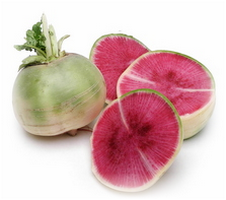 It is rare in Russia. "Berry" up to 8 cm. The shell is light green, the flesh is deep pink or dark purple. Less juicy than other varieties, very firm. The green part is bitter, the middle is slightly sweet and crispy. Contains a lot of potassium and dietary fiber. As it ripens, the "Watermelon" variety loses its taste. Spring radishes are smaller, winter radishes are larger and can be elongated. Dislikes dry soil.
It is rare in Russia. "Berry" up to 8 cm. The shell is light green, the flesh is deep pink or dark purple. Less juicy than other varieties, very firm. The green part is bitter, the middle is slightly sweet and crispy. Contains a lot of potassium and dietary fiber. As it ripens, the "Watermelon" variety loses its taste. Spring radishes are smaller, winter radishes are larger and can be elongated. Dislikes dry soil.
Polar bear F1
The mid-season hybrid "Polar Bear F1" is an achievement of Siberian breeders. Round white fruits are slightly spicy in taste, not flabby. The variety was created primarily for the northern regions. To accelerate maturation, growth stimulants are recommended.
Vienna F1
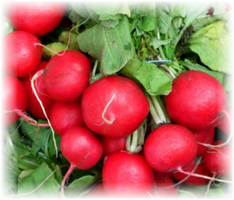 An early hybrid of 25 days. "Berries" up to 25 g, shiny. Light taste, milky core. Variety "Vienna F1" does not arrow.
An early hybrid of 25 days. "Berries" up to 25 g, shiny. Light taste, milky core. Variety "Vienna F1" does not arrow.
Vera MC
The variety is of the mid-season ripening period, 30-35 days. Red-purple round radishes become heavy up to 30 g with a "coverage" of 3.5 to 4.5 cm. The core can be pink-streaked. Excellent taste and shelf life. The Vera MC radish variety is best suited for the central regions of the country. The yield varies from 2 to 4 kg.
All-season radish
Early variety with high yields. From spring to autumn, it takes root well without shelter, in early spring and late autumn - in a greenhouse. Round radishes do not grow heavier than 20 g. Harvested as the fruit forms. All-season radish is resistant to flowering. Germination rate is 98%.
Würzburg 59
Medium late variety from Russian breeders with a good history. Ripens in 35-40 days. The color is red with a violet gleam under the skin. The pulp is possible with a pink tint. "Radishes" are slightly flattened, not sharp. Their average diameter is 3.5 cm, their weight is up to 17 g, they "sit" in the ground completely. The variety "Würzburg 59" is adapted to different climates and is planted in many countries. Doesn't get sick. Lighting and "lightness" of the soil are important. The usual harvests are up to 1.7 kg.
Gloriet F1
Hybrid of early ripeness of Japanese selection. Gloriet F1 is easy to grow all year round. The average fruit weight is 25 g. Can be grown larger without compromising quality. The heart is tender and tasty. The tops are low. The radish keeps well and does not flabber. Up to 2.5 kg are removed from a unit area. Germination rate is 98%.
Hussar
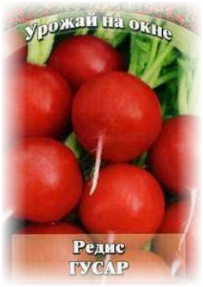 The variety is early maturing. "Rises" in 22-25 days. For the summer season, they are sown from early May to 20 July. Bright rounded "radishes" grow up to 3 cm in circumference with a mass of 22-30 g. Pulp with a small piquant peppercorn. Good indicators for disease resistance. The Gusar radish variety is suitable for balconies. Productivity 3.4 kg.
The variety is early maturing. "Rises" in 22-25 days. For the summer season, they are sown from early May to 20 July. Bright rounded "radishes" grow up to 3 cm in circumference with a mass of 22-30 g. Pulp with a small piquant peppercorn. Good indicators for disease resistance. The Gusar radish variety is suitable for balconies. Productivity 3.4 kg.
Dubel F1
The maturation period is 18-23 days. Root crops grow a little over 4 cm and weigh 30-35 g. Bright red. The pulp is dense with a crunchy texture. The culture is frost resistant. The variety does not arrow, the fruits remain intact. "Dubel F1" is excellent for commercial implementation. Good for "street" cultivation, any greenhouses and greenhouses.
Daikon
 From the Japanese group of radishes, sweet taste. The weight of the root crop can “go away” for 3 kg, and its “growth” can be up to 60 cm. It retains a juicy taste when shooted. "Daikon" is rich in calcium and potassium salts.
From the Japanese group of radishes, sweet taste. The weight of the root crop can “go away” for 3 kg, and its “growth” can be up to 60 cm. It retains a juicy taste when shooted. "Daikon" is rich in calcium and potassium salts.
Jolie
Medium early variety (up to technical ripeness 20-25 days), resistant to shooting, with short tops. Forms attractive "radishes" of a catchy red color of almost the same size, 15-20 g each, 3-4 cm in diameter. "Jolie" pulp is of special tenderness and juiciness. Heat tolerant. Keeps well. Possible yield up to 3.5 kg.
Diego F1
Early fruiting periods are 20-25 days. Dark red "circles" of root crops grow in "coverage" up to 5 cm, weighing 30-35 g. The pulp crunches juicy. The Diego F1 hybrid is an all-season one, it is not afraid of frosts and diseases. Convenient to store and transport. Yields up to 4.5 kg are possible. Loose "lightweight" soils are desirable.
Duro
Ripening period from 27 days to a month, mid-season. A "continuous cycle" of harvest is possible. Maintain a distance of at least 10 cm between rows. Quickly gains weight up to 40 g. In "coverage" up to 10 cm. Increased content of essential oils and minerals. The Duro radish variety is not susceptible to shooting and most diseases. The maximum yield is up to 3.4 kg per square meter. Germination rate is 98%. Easily withstands a drop in temperature. The fall harvest can be stored for up to a month.
Heat
Early ripening variety, one of the oldest. The fruit "pours" in 22-24 days. Rounded crimson-red radishes grow up to 27 g, almost completely "sit" in the ground. The pulp is milky-pink, dense in consistency, partly spicy, a lot of vitamin C. The "Heat" radish is well suited for early planting in greenhouses and open ground. You can sow "before winter" on the street, then the seeds are embedded in the soil up to 3 cm. The harvest in the season reaches 3 kg. Prone to stalking under long-term illumination. Perfectly stored and transported.
Zarya
Amicable early ripening dark red radishes grow in a greenhouse in 23 days, in the open air they ripen for a couple of days longer. The Zarya variety belongs to the early ones. The selection is Russian. Any type of cultivation. Radish diameter up to 5 cm, maximum weight 25 g. There is no bitterness in the juicy pulp. During a long daylight hours, in order to avoid flowering without the formation of a root crop, water the plants several times a week and shade them with a black film from 7 pm to 9 am. The first planting should be carried out in early spring, do not cluster. Harvest immediately before eating. From one square meter they collect up to 2 kg on the street, under cover - up to 3. Do not store at temperatures above 10 degrees Celsius.
Zlata
The mid-season radish variety "Zlata" boasts beautiful round-shaped yellow fruits in a month or a little more. Ripen amicably. For most of the fruit, radishes sit in the ground. They grow in a mass of 14-25 g (maximum 60) and a circumference of 2-3 cm. The surface layer is slightly rough. Yields yields up to 2.5 kg per meter of planting area. Withstands a lack of moisture, but grows larger with stable watering and care. Best yields on loose, "light" soils with good lighting. Good to store, easy to transport.
Ilke
Radish "Ilke" spring-summer cycle. Radishes are ready for 29-32 days from germination, they ripen together. Large size. They do not sag for a long time and do not "turn to stone". Outdoor variety suitable for conveyor production and commercial sale.
Cardinal F1
An early ripe hybrid. You can pull out the red flat-round "round" on the 23rd day of growth. At the same time, they grow up to 22-26 g. The pulp is pleasant to the taste, partly spicy. Even after long standing on the vine, "Cardinal F1" does not lose its taste. Gives up to 4.1 kg of products per square meter.
Carmelita
Early ripeness variety "Carmelita" pleases with harvest on average for 25 days. The first crops are from April 25 to May 20. Grows root crops up to 35 g in weight with snow-white pulp without bitterness, approximately equal in size. With a lack of watering, radishes become coarse and bitter. In case of overflow, they crack. The plant is not prone to premature flowering and stemming. Sow on light and loose soils. Remove up to 2 kg of radish. Well transportable.
Caspar F1
Shiny fruits up to 3 cm in diameter gain weight up to 25 g by 23-25 days. The optimum growth temperature is from 16 to 22 degrees. Juicy pulp taste without bitterness. The early ripe hybrid "Caspar F1" is resistant to hot weather. Excellent commercial and taste characteristics. Productivity up to 4 kg. They sprout up to 100%.
Kiwi
The rapid ripeness variety "Kiwi" is sown when the soil is warmed up to 10 degrees. It is desirable to have an illuminated, sufficiently moist area of lightweight soil."Cylinders" of radish are red-pink, with a white "edge" at the root, grow up to 5-7 cm with a diameter of up to 2 cm. Sweet-tender pulp. Sprinkler irrigation is the preferred method of irrigation.
King Kong
Medium early new variety. Marketable weight of the radish is 18-25 g. The outer shape is round, slightly flattened. The color is brilliant pink with the presence of red and white tips. Yields up to 2 and a little more kilograms. You can sow from April to July. Variety "King Kong" of Siberian selection, minimally prone to shooting. The taste is good. The use of growth stimulants is recommended.
Corundum
The germination rate of the early maturing variety "Korund" is 97%. On days 21-23, delicious radishes ripen together, 15 g each. The pulp is not bitter. The maximum yield is up to 4 kg per square meter. Root crops are well transported. They taste great.
Red giant F1
A late ripeness hybrid with a long-standing positive reputation. "Originally" from the Far East. The bright, pinkish-red, cylindrical fruits lengthen up to 17 cm. The pulp is pink-streaked. "Red Giant F1" is ready for 38-50 days from sowing, the main growth begins after a month of ripening. The giant is not subject to flabbiness and bloom at any size. Will endure short-term drought and attack of pathogenic microbes. Resistant to temperature drop. This giant is gaining weight up to 120-140 g with a coverage of 3.5 cm.It can be planted from the first days of April to the end of July. Open ground variety. The leaves go well for salad. Root vegetables withstand ripeness in the refrigerator for up to 2 months. They can be stored in professional storage for up to 4 months. Each square meter of the ridge gives 4 or more kilograms of radish.
The ripening period of the "Red Giant" variety is up to 50 days. Germination rate is 91%. The first root crops within a month. Mass of carmine-red radishes up to 100 g. Juicy pulp with a pink tint. It is not afraid of drought, it can be stored for a long time. Prefers slightly acidic nutrient soils. The desired air temperature during the day is at least 15 degrees. The first crops are from the end of April, "before winter" - in the beginning of August.
Mercado
The variety with high yields (up to 3.6 kg) ripens in 23-28 days. Root crops "Mercado" with a raspberry hue grow up to 5 cm, in circumference up to 3.5 cm. Weight of each 25-30 g. The inside is pinkish, dense structure, slightly "sharp", but sweet. Radish does not crack, does not fade, is resistant to cold. Can be grown all year round. Root crops of autumn planting are larger.
Lightning F1
The hybrid is very early maturing. Matures in a maximum of 25 days. Radishes up to 4 cm in diameter can grow up to 40 g. Their color is bright red. The pulp is vitreous, well preserved. "Lightning" gives about 2 kg of vegetables. In greenhouses, it can grow from February.
Mondial F1
The new hybrid is preferably open field. Ripening on day 25-28. The circumference of root crops is up to 4 cm. Each weight is 20-23 g. Mondial F1 does not tolerate thickening. Harvest up to 2.3 kg.
Mokhovsky
A variety of white round (sometimes oval) early maturing radish can be eaten in about a month. Snow-white, juicy, crunchy flesh excellent in taste. The root crop grows up to 4 cm wide and gains weight up to 23 g, slightly raised above the ground. The leaves are suitable for salads. Can be grown in greenhouses from January. Productivity from 700 g to 1 kg per unit area. Variety "Mokhovsky" of the Russian selection of 1994 zoning. When the temperature drops to 3-5 degrees below zero, radishes can be stored for up to one and a half months. In greenhouses, they collect 5-7 kg per meter of planting area, from open beds up to 1.5 kg. Germination rate is 95%. Attractive appearance, high marketability and excellent taste.
Om-Nom-nom
The early ripening variety "Yum Yum" presents delicious bright radishes for 18-20 days from sowing seeds. Each one gains weight up to 30 g. White juicy vitamin pulp. 98% of seeds emerge. The variety is all-season. Can be sown in the greenhouse from the beginning of March.
Parat
The ripening period of root crops is from 18 to 25 days. They grow up to 6 cm in girth, with a weight of under 30 g. Delicious pulp with pleasant juiciness. Suitable for seasonal cultivation.Variety "Parat" of German selection. Does not shoot, does not accept fresh manure. Respects light, well-lit open ground soils. Do not overexpose in the garden, there is a loss of taste.
Poker
Early ripening variety "Poker" with high yields ripens on 17-18 days. Suitable for a succession of summer sowing. Root crops are large enough, do not lose their taste and presentation for a long time. The pulp is dense, with a juicy crunch, rich in vitamins. 98% of seeds emerge.
Presto
The "fastest" of the radish varieties. The germination rate is 95%. Ripens in 16-20 days. Can be planted until September. Red round "berries" with a diameter of 3 cm, juicy gourmet taste without bitterness. Weight up to 25 g. They look great. For quality cultivation, it should not be colder than 7 at night, and 16 degrees above zero during the day. Variety "Presto" keeps fruits without cracking, does not shoot. It is possible to get up to 2.3 kg of radish from 1 sq. m.
Early red
The early ripening high-yielding variety "Early Red" can be grown in 24 days. From 97 to 99% of crops emerge. Root crops grow up to 5 cm in diameter. Their weight is 10-15 g. The sweet juiciness of the white-pink pulp lasts a long time. The variety grows on any soil in any light and above zero temperature. Doesn't go into shooting. Average yield of 1 kg per square meter.
Rebel
Beautiful round radishes are poured 18-20 days from sowing. The diameter of each is 3-3.5 cm. Weight is 15-20 g. Matte pulp of sweet taste. The "Rebel" variety is resistant to diseases, does not release shooters. Germination rate is 99%. Yield capacity - up to 2.8 kg.
Riesenbutter
In open ground it matures in 25 days, in a greenhouse up to 30. Prefers loose fertilized soils and bright sun. "Fruit" weighing 30-40 g, in coverage up to 10 cm. The inside is juicy and sweet. The germination rate of the "Riesenbutter" variety is 85%. Medium disease resistant. Up to 1.7 kg of the crop can be obtained per square meter. Does not woody and does not release arrows. Optimum temperatures for growth: 5-6 degrees Celsius at night and 16-18 during the day.
Rover F1
New early maturing hybrid. Grow bright, shiny "balls" of root crops up to 5 cm in diameter. Weighing 20-25 g. With a wide planting, you can get larger specimens. Rover F1 variety is disease-resistant and not prone to flowering. Prefers light soils with good "dressing" with nutrients. Moderate but frequent watering is desirable. In central Russia, it can be planted in unheated greenhouses in winter. Sowing in open ground begins at the end of April. Ripens in 18-25 days, up to 3 kg of radish per square meter.
Rhodes
An early ripening variety "gives" root crops 19-28 days from sowing. 98% of seeds come out. The mass of radishes of standard shape and color, 15-25 g each. Pleasant juicy heart of a white-pink hue, pleasant to the taste. "Rhodes" gives an average yield of 3 kg.
Rondar
Sowing hybrid of early spring and late autumn "Rondar F1" amicably gives out bright root-balls of red color to gardeners. Each weighs up to 30 g, coverage up to 3.5 cm. "Rondar" is resistant to disease. It is preferable to grow at a temperature of 15-18 degrees Celsius. Matures in 25-28 days. Productivity from 1 to 3.5 kg per unit of planting area. Not subject to color.
Ruby
Mid-season variety, beginning of harvest in 28 days. For all growing conditions. Radishes with a crimson color of a round or elongated shape. The mass of each "Ruby" grows up to 25-30 g with a "thickness" of 3-4.5 cm. It is prone to flabbiness and flowering. Gives up to 2.3 kg of "radish mass" per square meter with a friendly harvest. Germination rate is from 90 to 94%. High commercial quality.
Rudolph F1
The growing season in open beds is 20 days. Selective cleaning is possible for 16 days. Nice presentation. Disease resistant. Fruits do not become “woody” and grow up to 5 cm in diameter. A mass gain of up to 25 g is possible. The Rudolf F1 hybrid is good for spring sowing in a greenhouse. Radishes are formed amicably. The bright white flesh is slightly spicy. Remove up to 3 kg of vegetables from one meter of planting area.
Sachs
A popular early ripening variety of radishes.They form in 25-30 days, growing up to 10 g. The core is light pink in color, dense in consistency, spicy-sweet. A variety of varieties - "Saksa Korto" with larger roots up to 29 g and a yield of up to 1.3 kg.
Celeste
Fast ripeness hybrid "Celeste F1" gives root crops of high commercial characteristics. Bright, even, rounded or slightly elongated fruits are combined with boiling white pulp, which is very pleasant to the taste with a light peppercorn. It takes 23-25 days before the first harvest of Celeste radish appears. Radishes grow up to 5 cm or more in diameter. Root weight from 18 to 30 g. The hybrid is suitable for winter cultivation in a greenhouse. Not susceptible to shooters and pests. Remove up to 4 kg of vegetables.
Scarlett Globe
A friendly radish variety from Italy ripens in 22 days. Round radishes do not grow heavier than 12 g. Bright red, with a white and juicy heart without bitterness. Contains a maximum of vitamin C. Growing in open beds is preferred. Not susceptible to stalking and blooming. Scarlett Globe guarantees 100% purity.
Bullfinch
Radish of this variety actively grows for 18-20 days, "feeding" roots up to 20-25 g. The crispy glassy pulp of excellent juiciness is rich in essential oils. The Snegiryok variety is cold-resistant. Can be planted very early. Productivity up to 4 kg. Radishes do not spoil during transportation, retain their taste. The first plantings are at the end of April, the last at the beginning of September. 96% germination rate.
Tarzan F1
A hybrid of medium ripening periods, up to 30 days. The taste is slightly spicy. The weight of each root crop is up to 46 g, diameter is 5-7 cm. "Tarzan F1" is a hybrid of high commercial characteristics, resistant to diseases. Harvest from 1.3 to 2 kg of radishes per square meter. "Loves" fertile "breathing" soils and intense lighting.
Pharaoh
Deep red roots form their diameter up to 3 cm, average weight 15 g. Good preservation and transportability. The Pharaoh variety does not shoot. The term to technical maturity is 22-25 days. Gives up to 2.5 kg per meter of planting area. Minimally high in calories, "filled" with vitamins and fiber. Greens are suitable for salads.
French breakfast
Poured in 25 days. It is best planted in early spring, until September. Delicate red fruits of a cylindrical shape with a white tip grow up to 40-45 g. The core is juicy, without pungency and bitterness. Delicate sheets are used in salads. The French breakfast radish variety is resistant to blooming.
Champion
Variety of 100% germination, grows in 24-27 days. Root crops are slightly elongated with a somewhat convex head. Completely covered with soil. Not prone to flabbiness. Weight up to 20 g. In a circle up to 5 cm. The pulp is of a delicate consistency with a pleasant taste. Fertilizers with the presence of chlorine are strongly discouraged. The yield reaches 2.5 kg. "Champion" is resistant to disease.
Cherry bell
Early ripening of the variety, up to 21 days. The diameter of a round root crop is up to 3 cm. Weight is 20 g. Cherry Bell radishes are stored for a long time and can be transported without problems. At the same time, it does not crack or flab. The variety is cold-resistant, loves light soils. Each meter of planting area gives up to 1.4 kg of radish. Several crops can be harvested per season. Growing without shelter is preferred.
Cherriet
Hybrid for open ground "Cherriet F1" under favorable weather conditions bears the first fruits in 18 days. It grows well all year round, including in winter in greenhouses. The standard weight of a radish is 25-30 g, although it can grow larger. Any size does not affect juiciness and taste. The diameter "gets" up to 6 cm. You can collect up to 3.5 kg per unit area. Cherriet needs light, fertilized soil.
Expresso
Ultra-early ripening hybrid, 18 days. Root crops of deep red color are formed together. Gain up to 20 g in weight and up to 3 cm in diameter. The core is slightly sharp. The Expresso F1 hybrid is not subject to shooting. Ideal for low light conditions. Radishes retain moisture. The arrows are not released.
Each of these varieties has been tested by the labor of gardeners and received their well-deserved praise.Focusing on various selection criteria, we wish you to choose for your personal plot only the best, juicy and healthy varieties from the multitude that the "radish kingdom" offers today.
Today, it may even seem strange that radishes were previously considered an unusual and overseas vegetable. Some attributed to him mystical properties, either elevating his capabilities, then presenting him as something frightening and strange.
But in any case, it is worth noting that this vegetable helps to improve memory and increase immunity, having in its composition a huge amount of useful vitamins and minerals.
So that your harvest is worthy, and your efforts are not in vain, it is important to choose a variety that will taste good, give birth well and be able to attract attention with its appearance. After all, it is this product that needs to be served in the future.
Popular varieties
The most popular among all varieties are:
- Heat;
- French breakfast;
- The Red Giant is a late vegetable. It is special in that its roots can be stored in a cool place for several months... Such a crop ripens in 30-50 days. The variety got its name due to the size of the radish. The mass of such a vegetable can reach 0.3 kg;
- Zlata has bright golden color of the fruit with a slightly rough surface. The ripening period is 22-28 days. The weight of a medium-sized radish is 21 grams;
- Cherry Bella is a wonderful root vegetable that is distinguished by mild taste... It can be planted from April and the whole summer until September. In this case, the length of the day is completely unimportant for cultivation. It has a light taste with a slight spice.
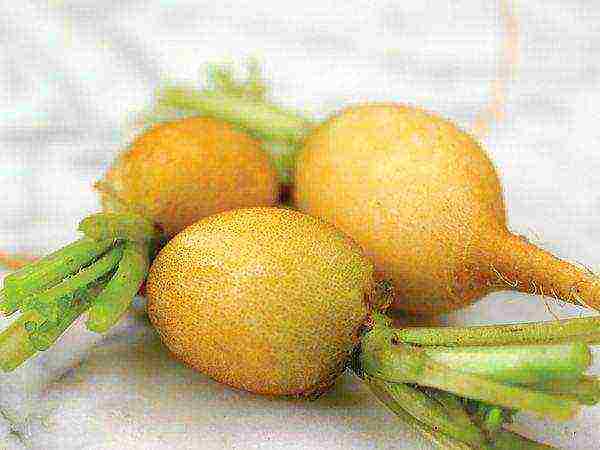 Radish Zlata
Radish Zlata
Shooting resistant
- Duro;
- Early red;
- Rondar F1;
- Lightning F1;
- Child F1.
For planting in open ground
- Ramtosh differs in that it is not at all capable of throwing out flowering. The root crop is white and fusiform in color. The pulp is white and tender with a medium-sharp taste. The variety is suitable exclusively for planting in the open field;
- Würzburg the variety can be harvested after 30-40 days after planting the seeds. The shape of its root crop is round according to the description. Its color is red with a slightly raspberry tinge. The pulp of the fruit retains its taste for a long time and does not deteriorate. That is why it is recommended to plant it not only in greenhouses, but also on open ground;
- Chupa Chups - a variety that in appearance is somewhat reminiscent of lollipops. Its roots are just as shiny and vibrant. The vegetable is very much to the taste of the kids. Since it is not spicy, but even a little sweetish. It is recommended to plant seeds in April and May at intervals of ten days if there are problems with germination. Up to 3 kg can be collected from one square meter of the site;
- Camelot can be planted both outdoors and in a greenhouse. The growing season is on average about 23 days. The pulp is firm and oily. It has a snow-white color. If you store the radish correctly, it will retain its taste for a long time;
- Cherry Bella.
Late ripening
- Red giant;
- Ice icicle stands out from other varieties in appearance... White root vegetable, slightly pointed towards the bottom in the shape of a cone. It reaches almost 20 cm in length. It tastes good, crunchy and juicy, has a slight edge and a slight bitterness. The crop of this variety can be harvested in 25 days, while the vegetable will reach its marketable appearance after 40 days;
- Dungan 12/8 stands out from all other varieties for its yield... From one square meter of land, you can get a practical 4 kg of the crop. The ripening period of the vegetable is 40-55 days;
- Würzburg radish;
- The autumn giant is white in color, oblong in shape and has a pleasant taste. The average weight of one fruit is 80-150 grams. Practice shows that this vegetable is stored and does not grow old for about six months... Its ripening period is 25-30 days.
Early ripening
French breakfast
This is an early ripening vegetable, which you can harvest literally in 22-23 days.
Early maturity is possible subject to suitable weather. This root vegetable is crimson on the outside and white on the inside.
To taste, the French breakfast has light note of pungency and bitterness... Many people note that this is a very juicy radish. The weight of a standard medium-sized root crop ranges from 15-20 grams.
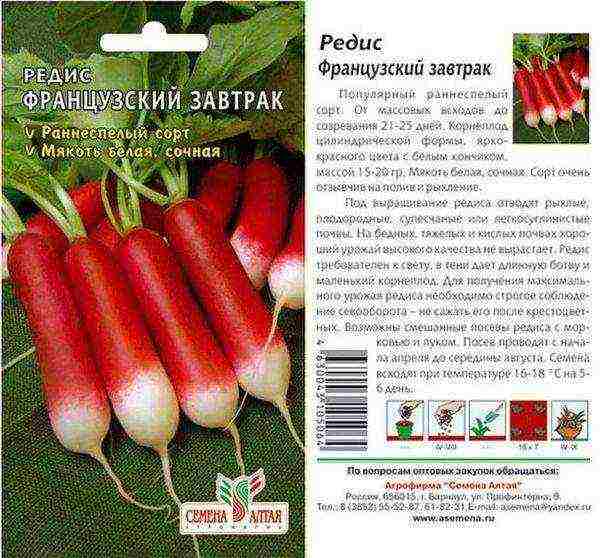 French breakfast
French breakfast
18 days
A variety of 18 days, which becomes clear from the name, is considered the earliest root vegetable, which is distinguished by its elongation and cylindrical shape. The average weight of the root crop is about 18 grams.
The outside color of the vegetable is pink with a white tail. Whereas the pulp is snow-white and dense. By its taste, radish is distinguished by a weakness of spice notes.
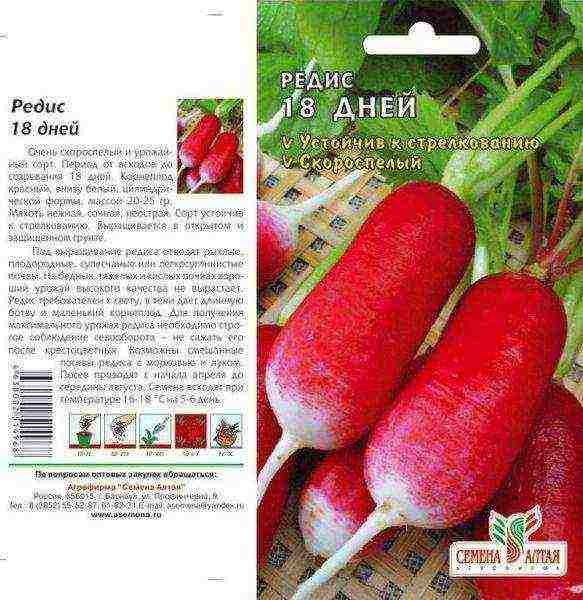 18 days
18 days
Firstborn F1
It is a hybrid variety that can be harvested within 18-19 days after planting the seeds. The root crop has a bright red or even crimson color. The average weight of a radish is 30-35 grams.
Do not forget also about high yield varieties. About 4 kg of radish can be harvested from one square meter. The plant tolerates heat well and is resistant to flowering.
This variety is recommended to be planted not only in the greenhouse, but also in the open field.
It showed good resistance to shooting. The root vegetable is pink in color and has a whitish tip. The vegetable is round and beautiful in shape. It also shows excellent qualities in taste.
Features of Radish Heat
Radish Heat belongs to the early maturing variety. Fruits ripen about twenty days after the emergence of the plant.
The radish root crop is distinguished by its roundness and smoothness of its outer side. In terms of color, it is a red vegetable with a slight raspberry tint. The mass of a medium-sized radish is about 30 grams. Its flesh is white.
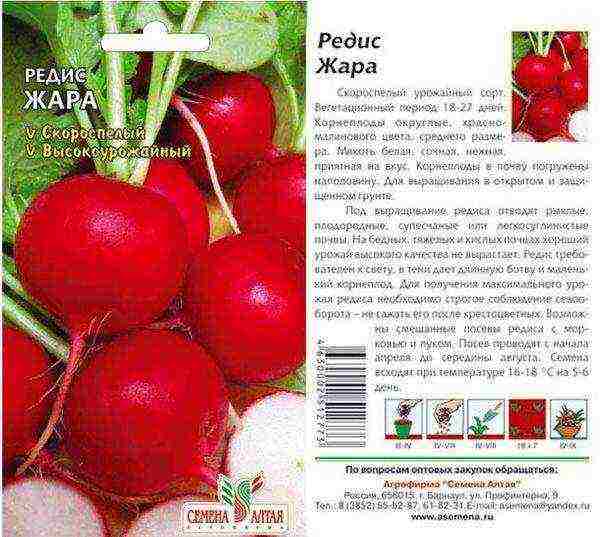 Heat
Heat
The pulp of the root vegetable is dense and juicy. Practical bitterness is not felt, although a hint of pungency is still present. The taste of the Zhara radish is quite high.
You can grow radishes by planting seeds in open soil or under a film covering.
It is customary to use radishes fresh or to add to salads.
Disease resistance
Initially, this vegetable variety was bred for hot countries. That is why root crops better tolerate high temperature readings than low ones.
Especially a vegetable afraid of freezing... This type of radish is distinguished by good protection against various kinds of diseases and flowers.
Care
- to get a decent harvest, you need to choose the right site for planting. In our case, this is the place where the snow is likely to melt. Thanks to this, you can get a fresh harvest as quickly as possible. The best option would be a soil that is different lightness and high fertility;
- all vegetables and berries, with the exception of the cruciferous family, can become the preceding plants that were previously planted on the site;
- before planting, the soil must be fertilized;
- most experts advise planting a crop in the last decade of April... If something went wrong, then you can re-land. But this is already in a couple of weeks;
- as soon as the first shoots appear, it is worth regularly loosen the ground;
- radish loves soil with high humidity, so do not allow the soil to dry out;
- if the crop has risen extremely thickly, you need to thin it out. The distance between individual roots must be at least 50 mm;
- if it is planned to plant plants in summer, it is recommended to shade the area. This is the only way to preserve the taste of the vegetable;
- to grow radishes in early spring or late autumn, it is worth additionally using film coatings.
A good harvest is always a lot of effort and labor of the gardener. And planting radish in this case is no exception. It is important to adhere to all the rules and recommendations that we considered in the article, and then beautiful and tasty root vegetables will decorate your table.
Foreword
The correct selection of radish varieties for each period of the sowing season will allow you to continuously receive a bountiful harvest, from the first warm weeks of spring to autumn. All varieties are divided into types according to the ripening period and the place of cultivation: in greenhouses or open ground.
Early ripening radish - harvest in 16 days
Ultra-early, as these varieties of radish are also called, ripen in 16–20 days. These include Ultra Early, F1 Baby, 18 Days, F1 Randar, F1 Firstborn. The latter is an ultra-early hybrid, which is distinguished by a high yield, reaching 3.8 kg / m2. Ripens in just 16-18 days. after sowing. Root crops resistant to shooting and not subject to cracking, large, round, dark red, weighing 30–35 g, with a juicy pulp of sweet taste. The variety is mainly intended for growing in open ground. Sowed from April to late August.
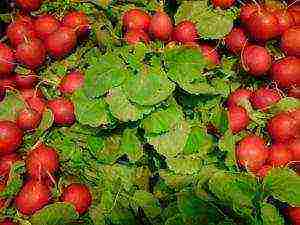
Rondar F1. Ripening time 18–20 days. The yield of this early maturing hybrid reaches 1 kg / m2. Root crops are red, with intense shine, rounded, weighing 10-15 g, with juicy, tender, white and pink-white flesh of excellent taste, which does not flake for a long time. This early hybrid has valuable qualities: high yield even in low light conditions, cold resistance, amicable ripening of root crops, resistance to flowering. Root crops Rondar are resistant to wilting, cracking and hollowness.
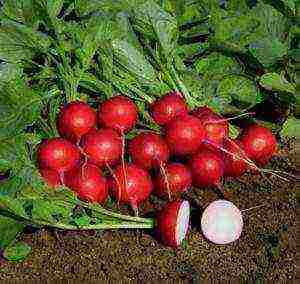
This variety is grown in open ground and greenhouse conditions in spring and autumn. Thanks to its short leaves, Rondar can be sown in cassettes.
18 days. Ripening period 18–20 days. Root crops are dark pink, cylindrical, oblong, with a rounded white tip. Juicy pulp of root vegetables of mild, delicate taste. Grows well in greenhouses outdoors.
Early Varieties - Heat or Early Red?
The fruits of early maturing radish varieties can be enjoyed in 21-30 days. from the moment of emergence. The most popular: Heat, Ilka, Early Red, Duro, French Breakfast, Zarya, Ruby and others.
French breakfast. A fairly popular and widespread early variety that yields a harvest for 24-27 days. after the first shoots. The yield reaches 3.7 kg / m2. Its roots are resistant to shooting, elongated-cylindrical, dark red, with a rounded white tip, weighing 40–45 g. Juicy pulp is not sharp and devoid of bitterness. The variety is suitable for open field sowing from spring in April to autumn in September. In the heat, it begins to go into the arrow.
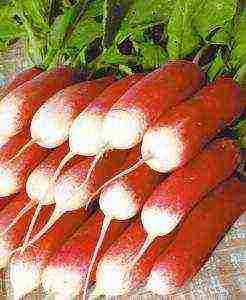
Ilka. Ripening period 24-28 days. Productivity in the range of 1.2-2.4 kg / m2. Root crops are red-scarlet, round, medium-sized, weighing 15–25 g, with juicy, dense, white and pink-white pulp, not subject to flabbiness and a pleasant medium-spicy taste that does not have bitterness. The Ilka variety is intended for sowing in open ground and greenhouse conditions; it can be grown all season, from April to September. In summer, from June to mid-July, when the daylight hours are the longest, it is recommended to shade the Ilka radish planting with a canopy. Advantages: resistant to low temperatures, does not shoot, is not prone to porosity, cracking and lining of root crops, on fertile light soils it is very high-yielding.
Duro. Harvesting ripe radish in 23-25 days. after the first shoots. It belongs to the most popular and productive early varieties. Its roots are red, round and extremely large: sometimes they reach 10 cm in diameter and 30–40 g in weight. Because of this, Duro radishes are sown according to the 10 × 10 cm scheme. The pulp of its roots is white and pink-white, tender, juicy crispy and delicious. This variety is resistant to stemming and flowering in hot weather and long days - optimal for growing in arid regions. Root crops do not woody and do not crack, they are stored for a long time. The variety is equally good for sowing in open ground and greenhouse conditions, it is characterized by amicable ripening of root crops.
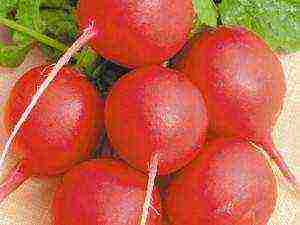
Heat. Ripening time 18-25 days. It is characterized by a high yield: based on the region, 0.9–2.9 kg / m2.Its roots are round, small in size, dark red, 15-25 grams each. The Zhara variety is time-tested and is very popular among gardeners. The radish has white-pink and white, juicy, tender, dense pulp with a slightly spicy pleasant taste, very rich in vitamin C. The variety is excellent for early sowing in open ground and in greenhouses. The name does not at all correspond to the preferences of this plant - it does not like heat, and it is not recommended to sow it in the summer (or it is necessary to cover it with a canopy).
Early red. Ripens in 24–31 days. Productivity in the range of 1.1-1.8 kg / m2. Its roots are small, smooth, round, dense, dark red, weighing 10–15 g. Early red is very juicy, its flesh is crispy, white, with a sweet-spicy pleasant taste. Advantages: germination rate of 99%; weak-leaved; Root crops are well formed on soils of various fertility in conditions of a long day and heat, ripen at the same time, are resistant to shooting and have high commercial qualities. The disadvantage is that it cannot be stored for a long time, it is intended for preparation and consumption only fresh. It is grown in any way (greenhouse or outdoors).
Mid-season varieties - the golden mean
Mid-season radish varieties ripen in 31–35 days. These include Saksa, Vera, Quantum, Alba, Zlata, Helios and others. Sachs. Ripening period 32–35 days. The yield reaches 1–1.6 kg / m2. Its root crops are of the correct round shape, raspberry-red, weighing 6-11 g, with juicy, white, delicate pulp of a sweet-spicy, pleasant taste. The Sachs variety is one of the most common species for early sowing in greenhouses, maturing amicably.

For early harvesting in the open field, it is used less often and not earlier than mid-spring. Suitable for summer cultivation. Disadvantage of Sachs: having reached technical ripeness, it is prone to early flabbling and going into the arrow.
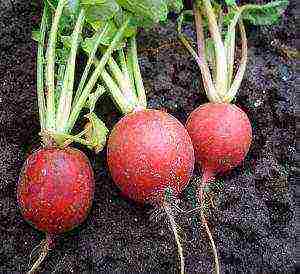
Quantum. Root crops are round, raspberry-pinkish, with juicy, slightly spicy pulp, pleasant taste. The crop ripens amicably, suitable for long storage. Faith. The yield can reach 2.4 kg / m2. Root crops are bright red, uniform in size, resistant to shooting and not prone to cracking, with white, juicy, tasty pulp.
Late-ripening varieties - harvest by autumn
Ripening period 36–45 days. By autumn, the Champion, Dungansky, Rampous, Moskovsky Greenhouse, Red Giant and others will be pleased with the harvest. Usually they are sown in the 1st third of August.
Red giant. The yield reaches 3 kg / m2. Its roots are large, cylindrical, on average 14 cm long, bright red, with juicy, pink-white flesh of a slightly spicy, pleasant taste. This variety begins to be sown from mid-July. It is very resistant to pests (bear, cruciferous flea), excellently stored in the sand (up to 4 months).
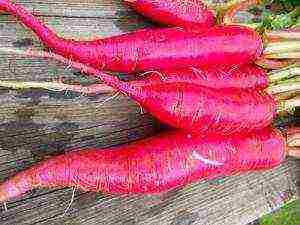
Champion. The growing season is 40 days. Radish Champion is a high-yielding late variety, yielding up to 1.1–2.7 kg / m2. Root crops are elongated-rounded, large, smooth, raspberry-red, weighing 18–20 g, with tender, juicy, dense, white and pink-white pulp of good taste. Radish Champion is ideal for sowing outdoors, and during the early period - indoors, in a greenhouse. Root crops ripen together, are resistant to voids, flabbiness and softening.
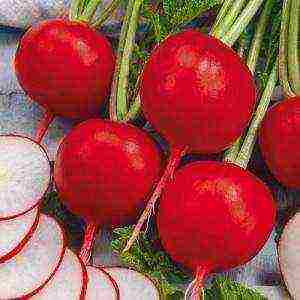
Dungan. Root crops are dark red, with a buttery pulp of a slightly spicy, pleasant taste. The variety is heat-resistant, loves watering, resistant to flowering. Grown in the second half of summer. Stores very well in winter. Rumposh. Matures 35–40 days. Root crops are long, fusiform, white, with the pulp of a rather spicy taste, but without bitterness. The variety is intended exclusively for growing outdoors.
Rate the article:
(2 votes, average: 4 out of 5)


